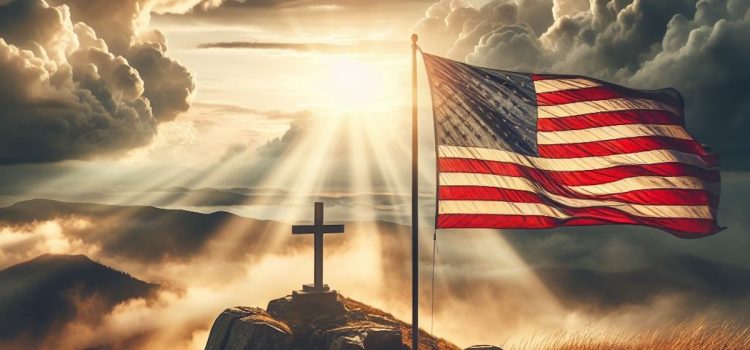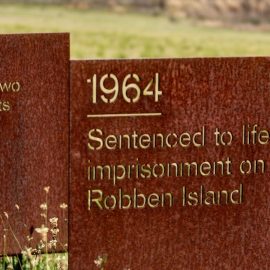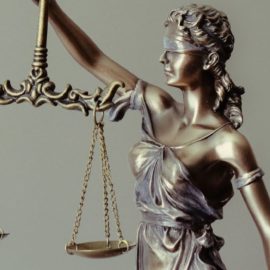
How are the election and presidency of Ronald Reagan connected to American Christianity? Who popularized the religious right?
In Jesus and John Wayne, history and gender studies professor Kristin Du Mez traces the link between politics and evangelical Christianity in America. She lays out the roots of the religious right and how it entered the mainstream in the 1980s.
Continue reading to learn about the rise of the religious right in America.
The Rise of the Religious Right
Du Mez writes that the rise of the religious right in America has its roots in the 1980 presidential election, which pitted Republican Ronald Reagan against incumbent Democrat Jimmy Carter. She describes this as a watershed moment for evangelical identity in the US, arguing that Reagan’s victory over Carter cemented the marriage between evangelicals and the political right. Even though Carter personally identified as an evangelical Christian—whereas Reagan was an infrequent churchgoer at best—evangelical voters embraced Reagan’s socially conservative policies and ruggedly masculine image.
Du Mez explains that Reagan intentionally built social capital with evangelical voters. For instance, while Reagan had previously supported the ERA as governor of California, he walked back his support while campaigning for president. Similarly, he began embracing evangelical policy points, such as supporting prayer in public schools and prohibiting abortion.
(Shortform note: Hot-button issues among evangelical voters are regularly in flux. For example, experts point out that evangelicals at the time didn’t oppose Roe v. Wade, the 1973 Supreme Court case that affirmed a woman’s right to an abortion in the first two trimesters—they saw abortion as an issue for Roman Catholics alone. Evangelicals, by contrast, only began mobilizing around pro-life causes in the late ’70s, following movements by evangelical leaders like Jerry Falwell Sr.)
However, Du Mez suggests that what ultimately sealed the deal for Reagan with evangelical voters was his perceived masculinity. Whereas Jimmy Carter was often deemed a “wimp” by critics, Reagan seemed reminiscent of a cowboy, even owning his own ranch in California. Moreover, Du Mez writes that Reagan reinforced this masculine appearance by becoming the “tough on crime” candidate who wasn’t afraid to ruthlessly punish criminals, even using violence when needed.
(Shortform note: The portrayal of Carter as a wimp stemmed from an accidental headline for a Boston Globe editorial piece following Carter’s 1980 speech on the energy crisis. While the headline was supposed to read “All Must Share the Burden,” author Kirk Scharfenberg’s facetious headline “Mush from the Wimp” ran instead in 161,000 copies before the mistake was caught.)
Consequently, Du Mez says, when the 1980 election came to pass, Reagan won the white evangelical vote in a landslide: 67% of white evangelicals voted for Reagan, even though 50% had voted for Carter in the previous election. Du Mez relates that, since that 1976 election, no Democrat has even come close to winning the majority of the evangelical vote. (Shortform note: In fact, white evangelical voters have become even more likely to vote Republican in recent decades. One study shows that 76% of evangelicals identified as Republicans in 2016—up from 61% in 1992.)
The Religious Right Enters the Mainstream
Although Reagan’s election cemented the marriage between evangelicals and the right, Du Mez clarifies that two key parties laid the foundation for this religious right during the 1980s: The LaHaye family and Jerry Falwell Sr.
She notes that the LaHaye family includes Tim and Beverly LaHaye, each of whom played a role in strengthening the religious right. For his part, Tim LaHaye was a pastor whose books in the early 1980s stoked a sense of embattlement on behalf of evangelicals. He argued that progressives were undermining key aspects of evangelical life, such as education and the family, meaning evangelicals needed to align themselves with the right. Beverly LaHaye founded Concerned Women for America (CWA), an influential evangelical organization that targeted the progressive feminist agenda throughout the 1980s.
Similar to the LaHayes, Falwell Sr. was essential to bringing the religious right into the political mainstream. As Du Mez relates, he created the Moral Majority in 1979, an organization that sought to mobilize the religious right in elections throughout the 1980s. In particular, Falwell Sr. promoted a militaristic approach and advocated that America maintain a dominant military to fend off domestic and international threats, largely from Marxists who, according to Falwell, wished to undermine the evangelical family unit.
| The Formation of the Religious Left Although the religious right’s influence grew significantly during the ’80s, some experts contend that the religious left—a group of progressive politicians and activists whose religious faith is central to their image—is exerting increased influence in contemporary American politics. Broadly speaking, the religious left is centered around the social gospel, an attempt to apply parts of Jesus’ teachings to remedy societal injustices. Historically, some credit the religious left with the abolitionist movement in the US preceding the Civil War. This movement, researchers relate, was composed largely of churchgoers who believed slavery was contrary to humanity’s God-given rights. In the 21st century, the religious left has mobilized around issues such as racial equality, poverty mitigation, and the treatment of immigrants. For example, Secretary of Transportation Pete Buttigieg—a progressive politician and Episcopalian Christian—strongly critiqued Donald Trump’s immigration policies on the grounds that God wouldn’t condone placing children in cages and separating families at the border. |






